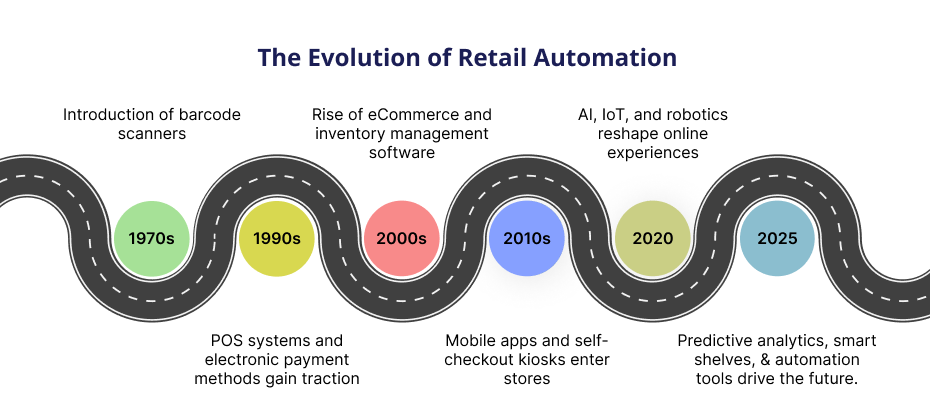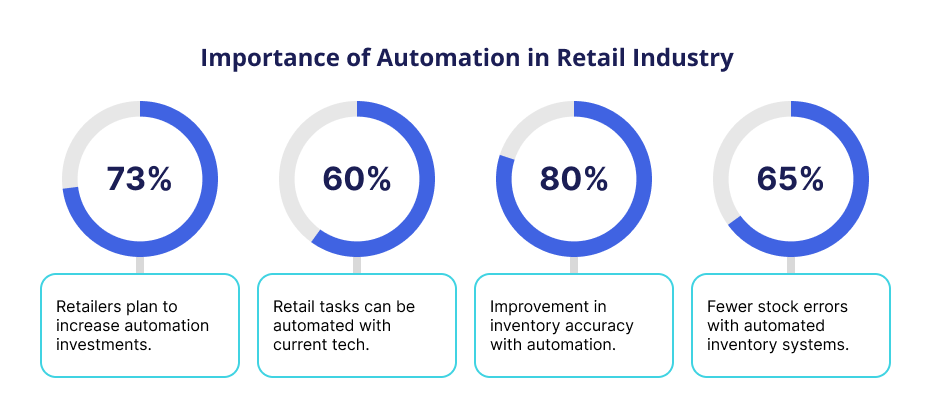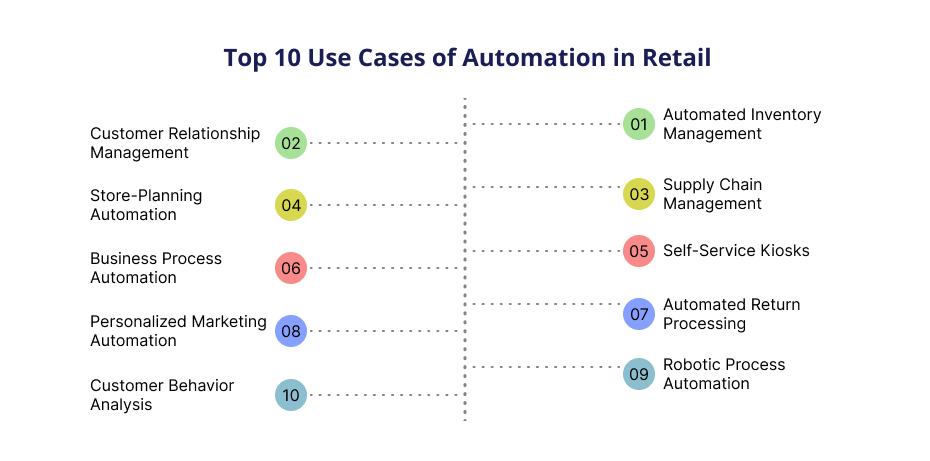Retailers today are under massive pressure. Customers expect 24/7 shopping, hyper-personalized experiences, and instant delivery. Additionally, labor shortages, inventory mishaps, and long checkout lines deter shoppers.
Meanwhile, rising consumer demands and razor-thin margins leave little room for inefficiency. Thus, to stay agile, businesses are turning to automation in retail that facilitates operations and enhances the shopping experience.
From AI-driven inventory management software that predicts stockouts to cashier-less stores that eliminate queues, retail automation is transforming the industry. Moreover, businesses can benefit from smart sensors that alert them to restock shelves before they become empty, chatbots that resolve customer queries, or algorithms that offer personalized recommendations.
But the big question is, how can retailers make this shift? What technologies should they explore? And how do they tackle challenges? In this blog, we’ll discuss everything you need to know, from key technologies to benefits to costs, and also provide you with steps to implement automation in the retail industry.
What is Automation in Retail?
Automation in retail means using intelligent technologies, such as AI, sensors, and RFID, to automate repetitive tasks. It includes restocking shelves replenishing inventory, tracking inventory, and processing sales, thereby allowing decision-makers to focus on more complex tasks like market expansion, product innovation, and more.
For example, self-checkout kiosks, AI chatbots answering “Where’s my order?”, or systems that auto-reorder products before they sell out. It’s retail automation software that streamlines everything from supply chains to customer loyalty programs.
The Evolution of Retail Automation
Retail automation has evolved over the decades, progressing from basic barcode scanners to today’s AI-powered systems. Each leap has helped retailers become faster, more innovative, and more customer-centric. As technology continues to advance, so does automation, changing how we shop and how retail businesses operate.
Here’s a quick timeline that shows how far we’ve come:

The Importance of Automation in Retail Industry
Why should retailers care about automation? With labor costs soaring and customers expecting instant everything, manual processes just don’t cut it. From smoother operations to smarter customer experiences, it’s changing the game.
According to reports, the worldwide retail automation market size was valued at $27.6 billion in 2024 and is expected to reach $44.3 billion by 2029. Therefore, there are significant opportunities for thought leaders to invest in intelligent retail automation solutions to enhance operational agility.
Let’s look at how forward-thinking retailers are benefiting from automation in retail industry below–
- Real-time inventory updates
- Personalized shopping experiences
- Faster checkout processes
- Predictive demand forecasting
- Reduces operational costs
- Enables data-driven decisions
- Improves business scalability
If you’re still unsure about its impact, these numbers speak for themselves:

Key Technologies Driving Retail Automation
Automation in retail isn’t powered by just one tool, it’s a combination of innovative technologies working together. From custom AI solutions to robots sorting packages, each tech plays a role in improving the customer experience. Let’s break down the key ones, with examples you’ll easily relate to.
1. Artificial Intelligence (AI) and Machine Learning (ML)
AI and ML are the brains behind digital transformation in retail. They analyze data to predict trends, personalize offers, and even detect fraud. Have you ever noticed how Amazon recommends products you might love? That’s AI in retail industry learning from your behavior.
Example: Stitch Fix, an online personal styling company, uses machine learning (ML) algorithms to analyze style and ship curated outfits.
How do ML/AI solutions for retail help?
- Predicts product demand to avoid overstocking
- Recommends products to boost cross-selling
- Detects flag fraud by identifying unusual purchase patterns.
2. Internet of Things (IoT) and Smart Devices
IoT connects everyday retail equipment to the internet. This enables devices such as shelves, freezers, or checkout counters to send and receive real-time data. As a result, retailers can track inventory, monitor equipment health, and improve overall efficiency.
Example: Smart shelves in stores like Kroger have weight sensors that ping staff when peanut butter is low.
How do IoT and Smart devices help retailers?
- Track inventory in real-time via RFID tags.
- Monitor fridge temps to prevent spoilage.
- Heatmaps show busy aisles to optimize layouts.
3. Robotics, Drones, and Autonomous Systems
Robots and drones handle repetitive tasks like sorting, packing, and delivering. Think of Amazon’s robotic fulfillment centers, where machines pick and move thousands of items every hour with high precision.
Example: Walmart’s shelf-scanning robots roam aisles, checking prices and stock.
How do automated retail solutions help in business?
- Robots restock shelves overnight.
- Cuts down on delivery time with drones
- Autonomous forklifts sort warehouse pallets.
4. Computer Vision and Facial Recognition
Computer vision enables systems to “see” and interpret images or videos. Retailers use it to track customer movement in-store to optimize layouts and product placement.
Example: Amazon Go stores, which utilize cameras to track what you select. No cashiers needed. Simply walk out, and your card will be charged.
How do these technologies help the retail industry?
- Cameras detect items at checkout.
- Facial recognition flags shoplifters.
- Analyzes foot traffic to redesign stores.
5. Augmented Reality (AR) and Virtual Reality (VR)
AR and VR make shopping more interactive. They allow customers to virtually try on clothes, accessories, or even visualize furniture in their own homes. This creates a fun and engaging experience, reducing return rates. Moreover, it reduces product returns and builds buyer confidence.
Example: IKEA’s AR app enables customers to visualize furniture in their homes before making a purchase.
How does an AR/VR app help automation in retail?
- Virtual try-ons for clothes, glasses, furniture, and makeup.
- Reduces return rates through better visualization
- Offers immersive shopping and brand experiences
Top 10 Use Cases of Automation in Retail
Retail is a tough gig with empty shelves, endless lines, and guesswork in ordering stock. A survey by Capgemini found that retailers experienced an 11% increase in customer visits after implementing automation technology in their retail stores. Let’s see the applications of automation in retail that will solidify our statement.

1. Automated Inventory Management System
Inventory is like the heartbeat of any retail business. In the past, store owners would manually count their products or use spreadsheets to track them. But now, with so many ways for customers to shop, like ordering online, picking up in-store, or choosing home delivery, managing inventory has become way more complicated.
That’s where automated inventory management helps. It takes the load off by keeping an eye on stock levels, placing reorders automatically, and avoiding costly mistakes.
- Figure out how much stock to order based on busy seasons or trends.
- Track expiry dates for perishable items to cut down waste.
- Utilize smart sensors (IoT) and a retail automation platform to track product locations across multiple store locations.
2. Customer Relationship Management (CRM) Automation
CRM systems help retailers keep all customer details in one place. Whether someone shops online, in a store, or messages on social media, CRM tracks all of it.
With that information, retailers can build automation software to facilitate intelligent decision-making. It gives businesses a clear picture of each customer’s journey.
- Trigger emails based on specific behaviors, like cart abandonment or previous purchases.
- Instantly apply or notify customers about loyalty points, discounts, or exclusive deals.
- Maintain a single view of the customer for marketing, sales, and service teams.
3. Retail Supply Chain Management (SCM) Automation
Retail supply chains are getting harder to manage because of high material costs, fewer workers, and shipping delays. So, stores are now using automation in retail industry to handle everything, from predicting customer demand to managing warehouses and delivering products.
Businesses can consider supply chain software development services to create an intuitive application that enhances efficiency by streamlining processes. Improves safety by reducing the need for heavy lifting or manual handling.
- ERP software connects suppliers, manufacturers, and retailers in real-time.
- AI in supply chain management enables the selection of optimal delivery routes and more accurate inventory management.
- RPA handles routine tasks like data entry and paperwork.
4. Store-Planning Automation
The arrangement of a store and the placement of products play a significant role in how people shop. Store-planning automation helps retailers figure out the best way to place items, so customers see and buy more.
For example, online stores can use AI and automation in retail to change the website layout, move popular products to better spots, and show personalized items based on what shoppers do in real time.
- Designs displays attract more attention.
- Measures how long customers stay on pages.
- Improves click-through rates with better item placement.
5. Self-Service Kiosks and Self-Checkout Systems
Self-checkout machines and kiosks are one of the most noticeable ways in retail store automation. In 2023 alone, stores added over 217,000 new ones worldwide, and this number is only expected to grow.
These machines help customers check out faster, reduce errors, and allow employees to focus on other essential tasks. They also collect useful data about how customers shop.
- Reduce mistakes that can happen with manual billing.
- Gather customer data from usage patterns and behaviors.
- Improve store speed and efficiency during busy hours.
6. Business Process Automation
Every aspect of running a store, from stocking shelves to interacting with customers, generates valuable information. But because this information is often kept in different places, it’s hard for store owners to put it all together and use it smartly.
With business process automation in retail, stores can identify trends such as which products are gaining popularity and quickly restock before they run out. They can also identify which items aren’t selling well, determine where deliveries are slowing down, and adjust prices accordingly.
- Finds patterns in sales and customer choices.
- Helps forecast what might happen in the near future.
- Offers suggestions to improve performance and fix issues early.
7. Automated Return Processing
With online shopping becoming super popular, people now expect returns and exchanges to be fast and easy. According to a 2024 report by the National Retail Federation and Happy Returns, the average return rate for ecommerce was 16.9%.
Consumers returned products worth $890 billion. Therefore, stores must handle returns efficiently and accurately, as failing to do so risks losing customers.
- Sends out return labels and automatically tracks items.
- Speeds up refunds and restocks items faster.
- Automation in ecommerce helps multiple returns without a mess.
8. Personalized Marketing Automation
Marketing automation in retail is like smart help for stores. It watches what customers do, such as what they look at or buy. And then uses that information to send them the right emails, ads, or social media posts. This helps stores talk to the right people at the right time and sell more.
- Sends personalized messages.
- Targets the right audience.
- Increases chances of sales
9. Robotic Process Automation and AI-Driven Chatbots
Unclear communication in phone-based customer service is bad for both retailers and customers. RPA in the retail industry helps eliminate long waits. Experts predict that AI chatbots will save retailers $80 billion in labor costs by 2026.
AI-powered chatbots utilize machine learning (ML) algorithms and natural language processing to comprehend what customers are saying. They gather information from systems such as customer databases and order management systems to provide personalized responses.
- Check order status, process returns, and answer product questions.
- Provide shipping updates and assist with website/app navigation.
- Transfer complex queries to live agents.
10. Customer Behavior Analysis
Behavior analysis is like reading your customers’ habits. It helps stores understand what people buy, how they shop, what they return, and other key insights. It leverages artificial intelligence in the retail industry to anticipate what customers might want next, identify issues, or adjust operations accordingly.
For example, a store might notice a product sells more in early November, or one customer might buy the same item every 3 months. It’s all about knowing your customers better and using that info to serve them smarter.
- Guides on where to put products in the store or on the website for better sales.
- Tells stores when to have more or fewer employees on the floor.
- Makes shopping easier for customers and reduces returns.
Benefits of Automation in Retail Industry
Retail automation enables stores to operate more efficiently, effectively, and with fewer errors. From stocking shelves to assisting customers, it streamlines daily tasks, boosts profits, and enhances the shopping experience.
Minimizes Human Errors
One of the benefits of AI automation is that it takes over repetitive tasks that humans often perform incorrectly, such as entering prices, tracking inventory, or updating orders.
Improves Data-driven Decision-making
Automation tools collect and analyze store data to help owners make informed decisions quickly, such as identifying what sells well or when to restock.
Streamlines Sales Process
Among the other benefits of retail automation is that it streamlines the selling journey, from billing to follow-ups, allowing customers to check out faster and enabling staff to work more efficiently.
Maximize Efficiency
By automating tasks such as stock management and payment handling, stores can run smoothly even with fewer staff members.
Enhances Customer Experience
Automation enables stores to serve customers more effectively with faster service, personalized offers, and real-time support.
Cost of Implementing Automation in Retail
Retail automation may seem expensive at first, but it is an investment that pays off over time. From setup to ongoing maintenance, every cost brings long-term benefits, including improved efficiency and enhanced customer satisfaction.
For a small to medium-sized retail store, the mobile app development costs with automation can range from $15,000 to $100,000+. However, for a large-sized store, the prices can range from $30,000 to $200,000.
Retail Automation Cost Breakdown
| Cost Category | Estimated Cost Range | What It Includes |
| Hardware & Devices | $5,000 – $50,000+ | Self-checkout kiosks, scanners, IoT sensors, handheld devices |
| Software & Licensing | $2,000 – $20,000/year | Automation platforms, AI tools, CRM, ERP, cloud storage |
| System Integration | $3,000 – $15,000+ | Connecting new tools with existing POS, inventory, or customer systems |
| Training & Upskilling | $1,000 – $5,000 | Employee training for using new systems |
| Maintenance & Support | $500 – $5,000/year | Regular updates, bug fixes, system monitoring |
| Customization & Upgrades | $2,000 – $10,000+ | Tailoring tools to business needs, adding new features |
Note: These costs vary based on store size, type of technology used, and vendor choices.
How to Get Started with Retail Automation?
Getting started with automation in retail isn’t as complicated as it sounds. With the proper steps, even small businesses can utilize automation to save time, minimize errors, and enhance customer satisfaction. Let’s look at the steps below–
Evaluate Business Needs and ROI Potential
Before jumping in, take a step back and think, what’s eating up the most time or causing the most errors? Identify those areas and check if automation in retail can solve the problem while offering a good ROI. A little planning now can save a lot of money later.
Pick Low-Hanging Use Cases
You don’t need to automate everything at once. Start with small, easy-to-implement tasks like inventory alerts or automated emails for abandoned carts. These quick wins build confidence, show results fast, and make scaling up smoother down the road.
Partner with the Right Technology Vendors
The right tech partner can make all the difference. Look for a reliable eCommerce development company that understands retail challenges, offers dependable support, and has solutions that grow with your business. You should request demos and real-world examples before committing.
Train the Workforce with Automation
Automation doesn’t replace people, it helps them do their jobs better. Train your staff to use new tools, understand how automation works, and work alongside it. When your team is confident, the whole system runs more smoothly.
Challenges of Implementing Automation in Retail Business and Their Solutions
While automation brings considerable benefits, it’s not always smooth sailing. Retailers often face a few bumps along the way. However, with the right approach, challenges in retail industry have a smart and simple solution.
1. High Upfront Costs
Let’s face it, automation tech isn’t always cheap. But think of it as an investment, not an expense. Start small with budget-friendly tools that show quick wins. Over time, the savings from better efficiency and fewer errors often outweigh the initial costs.
2. System Integration Complexity
Connecting new technology with your existing systems can feel like trying to fit puzzle pieces together. The fix? Choose automation tools that are flexible and compatible. Work with an AI development company that offers excellent support and expertise to ensure everything works smoothly together.
3. Managing Organizational Change
People naturally resist change, especially when tech is involved. To ease the transition, involve your team early on. Explain how automation helps them, not replaces them. Offer training and listen to their feedback. When employees feel included, they’re more likely to get on board.
4. Data Privacy Concerns
With the increased automation and AI model development comes an increase in customer and transactional data. It means an added responsibility. To stay safe, always use tools with built-in security features. Follow data privacy laws, use secure networks, and limit access to sensitive info. A secure system builds customer trust and protects your business.
Future Trends of Automation in the Retail Industry
The future of retail is getting smarter, faster, and greener. With automation leading the charge, retailers will offer better experiences, work more efficiently, and meet customer needs like never before.
Autonomous Delivery Vehicle
Soon, you might get your online order delivered by a driverless vehicle. These innovative delivery options save time, cut labor costs, and reduce emissions. For example, some grocery chains already use robots to deliver items to nearby neighborhoods, which are quick, contactless, and super convenient.
Voice commerce and AI assistants
Imagine saying, “Order shampoo,” and your smart speaker does the rest. That’s voice commerce. AI assistants will make shopping easier by handling orders, answering questions, and even making personalized suggestions based on your preferences.
Generative AI in Retail Automation
Generative AI is shaking things up by creating product descriptions, generating ads, and even designing store layouts automatically. For example, GenAI in retail can analyze trends and instantly write catchy product listings to save time and boost sales for online stores.
Augmented Reality Shopping Experiences
Trying before buying is getting a digital upgrade. Augmented reality in retail lets customers “see” how clothes, furniture, or makeup look on them through a phone or screen. Big brands already let shoppers visualize furniture in their living rooms before making a purchase.
Sustainability and Green Automation
The future of automation isn’t just smart, it’s green as well. Retailers are utilizing eco-friendly robots, energy-saving systems, and intelligent inventory management tools to minimize waste. For example, green automation in retail can help track expiry dates and prevent overstocking, thereby reducing unnecessary packaging and waste.
Build Innovative Retail Automation Solutions with SparxIT
At SparxIT, we help retail businesses like yours make the most of automation. Whether you want to speed up your checkout process, personalize shopping experiences, or track inventory in real time, we’ve got you covered.
Our experts utilize modern technologies, including AI, IoT, and data analytics for automation software development that effectively addresses your day-to-day challenges. Plus, we make sure everything runs smoothly with your existing systems. So, whether you’re just starting or looking to scale, SparxIT can turn your automation ideas in retail industry into practical, innovative solutions.
Let’s team up to create a more efficient, engaging, and profitable retail experience for your customers.

Partner with Experts
Frequently Asked Questions
How does automation in retail industry help?







Automation in retail sector helps streamline tasks such as inventory tracking, billing, and customer engagement. It reduces errors, saves time, and boosts efficiency. Plus, it frees up staff to focus on what humans do best, building relationships!
What are examples of automation in retail?












Self-checkout kiosks, AI chatbots answering FAQs, smart shelves that alert staff when stock is low, and robots tidying aisles. Oh, and cashier-less stores like Amazon Go. These tools help retailers run smoother operations while offering faster, more personalized services to customers.
What technologies are commonly used in retail automation?












Retailers often use AI for predictions, IoT sensors for real-time tracking, robotics for warehouse tasks, and computer vision for theft detection. These technologies work together to optimize processes, reduce costs, and maintain optimal stock levels on the shelf.
How can artificial intelligence in retail improve customer service?












AI personalizes recommendations, answers queries instantly via chatbots, and even predicts trends to keep shelves stocked. As a result, shoppers feel more understood, and their experience becomes faster and more satisfying.
Can SparxIT develop custom automation solutions for retail businesses?












Absolutely! SparxIT specializes in creating tailored retail automation solutions, whether it’s a custom inventory tracker, AI-powered analytics supply chain automation, or in-store tech. We even ensure it integrates with your existing systems.




